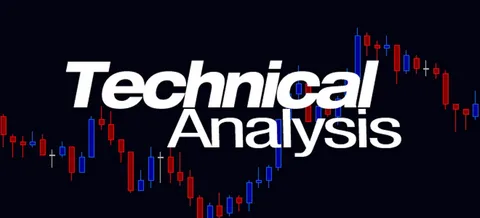Simple Technical Analysis Tools for Private Investors
Technical analysis constitutes a valuable approach for private investors who base their investment decisions on market data. Investors can identify market trends and the direction of future prices by critically analyzing past data on prices and volumes. In the face of complex tools, newcomers and practitioners with little experience discover that simple technical analysis techniques perform very well. Using such tools, investors can readily identify market sentiment and exploit profitable prospects.
The main goal for individual investors is to use technical analysis so as to read the current state of the market and predict movements in the prices. Irrespective of whether you are investing in stocks, forex, or even cryptocurrencies, these tools show you important information about what drives market behaviour. The good news, however, is that fundamental technical tools are very user-friendly and can be understood without any background in computer science or intricate financial models. The use of very simple yet effective technical analysis tools can help investors feel more confident about their trading moves.
In this article, we will discuss simple technical analysis tools that private investors can use to optimize their trading strategies. All these tools—moving averages, candlestick charts, and others—provide different information that will help you make more grounded decisions.
Moving Averages: A Fundamental Indicator
One of the most common technical analysis tools is moving averages, which allow investors to easily filter out price volatility and point to market trends. The moving average (MA) tracks the moving average cost of a security over time, such as 10, 50, or 200 days. The two moving averages most widely applied are the simple moving average (SMA) and the exponential moving average (EMA).

Private investors can use moving averages to determine whether the market is in an uptrend or a downtrend. If a market price is above a moving average, it is a sign of an uptrend, while if it goes below, it is a sign of a downtrend. Additionally, moving averages are flexible price anchors that can signal turning points in the market for investors.
Although moving averages are based on historical data and are somewhat backwards-looking, they are very important in understanding the direction of markets generally. Using both short-term and long-term moving averages allows private investors to measure the strength of the market trends and provide better investment decisions.
Support and Resistance Levels: Key Price Barriers
Despite being easy to comprehend in technical analysis, support and resistance levels are key to forecasting market direction changes. At a support level, purchasing such an asset normally stabilizes the price, which becomes a lifesaving wall against additional losses. A price at which sellers prevail creates a barrier to the upward movement of the price, meaning resistance.
Determining support and resistance levels gives private investors a relative clue to entry and exit positions. For example, if the price breaks through a support point and reverses, it is buying in. On the other hand, if the price touches a resistance level and starts to go down, this implies that sellers are superior to the market.
The ethnicity of support and resistance levels makes them vulnerable to change through changes in the market situation. Through these levels, investors can make appropriate entry and exit decisions as they buy in when the price touches support and sell high when near resistance.
Candlestick Charts: Decoding Market Sentiment
Candlestick charts provide an easy and efficient instrument for technical analysis. Each candlestick visually conveys a period duration and the introductory, maximum, minimum, and finishing prices. The candlestick’s body shows the range between opening and closing prices, while the wicks or shadows will reveal the high and low of the period.
Candlestick patterns will help traders to get valuable information about current market sentiment. If a small red candlestick is followed by a larger green one, this is called bulls engulfing pattern, which may indicate when an uptrend reverse may be done. Otherwise, if a small green candlestick indicates by its size a small green stick and a light red one refers to a large one, then it can be regarded as the signal about the possible further down movement.
Candlestick charts help independent investors measure market sentiment and predict possible price adjustments. Knowing what important candlestick formations mean helps investors make more confident buying and selling decisions.
Relative Strength Index (RSI): Measuring Market Momentum
The Relative Strength Index (RSI) is an indicator of the momentum of price movement changes. RSI reaches 0-100 and can be considered a tool for determining the conditions of overbought or oversold assets in the market. An RSI greater than 70 is, in most cases, a sign of overbought conditions and coming price adjustments. Whenever the RSI goes below 30, it indicates that the asset is oversold and may rebound from the oversold territory.
RSI is a good resource for private investors hoping to identify the right time to buy or sell. When levels of RSI get to these levels, it indicates that prices are prone to reverse. However, it is important to use RSI with other trend indicators because sometimes circumstances can accommodate extended periods of over-bought or over-sold conditions before any reversal.
The RSI helps investors time their trades, though its precision increases with its combination with other technical analysis tools to confirm market patterns and the possibility of erroneous signals.
Bollinger Bands: Analyzing Price Volatility
Bollinger Bands provide a useful tool for private investors to follow price movements and monitor when they can make potential trades. The bands have three elements—two standard deviation lines and a central moving average line. A simple moving average delineates the midpoint, and the outer boundaries are established due to increases in standard deviation, with two standard deviations commonly used to set the upper and lower bands. Market fluctuation is used to measure the gap between the upper band and the lower band in Bollinger Bands.

Whenever a price gets close to the upper band, it may indicate that the asset is a bit overbought, while a price that approaches the reverse band may indicate an oversold condition. When prices breach the upper or lower bands, it may be taken as a signal for an important price movement, which gives private investors an opportunity to pivot their trades.
Bollinger Bands allow investors to determine the market volatility level and make more informed decisions concerning their trade time. In addition to other technical indicators, Bollinger Bands can be used by investors, as it may improve their chances of identifying high-probability trade setups.
Volume Analysis: Confirming Trends and Reversals
Volume analysis effectively verifies whether price changes are part of a trend or a mere anomaly. The volume measurement indicates the number of shares or contracts transacted within a particular period. An uptrend with increased volume typically strengthens its momentum, and a lower volume in equilibrium can indicate a trend reversal.
Volume analysis is essential for private investors to determine how strong a trend can be. A spike in volume accompanied by price fluctuation mostly indicates that the situation over-riding trend should proceed. If, however, the move results from relatively low trade volumes, it can represent a sign that the trend is starting to lose momentum and may begin to reverse.
Trade decisions can be refined by applying volume analysis and other market indicators. Sciencing volumes help private investors gain useful insights into whether the prevailing trend is sustainable or should be followed by an exit plan.
Moving Average Convergence Divergence (MACD): Identifying Trend Changes
Private investors reap the gains from MACD, a trend-following momentum indicator which assists in determining the changes in strength, direction, momentum, and duration of a trend. MACD line is calculated by subtracting the 26-day EMA from the 12-day EMA. The MACD signal line is generated by researching a nine-day EMA of the MACD line.
A cross above the signal line is a bullish signal, indicating that the trend may be ascertaining its movement up. On the other hand, a fall of the MACD line below the signal line indicates a bearish outlook, indicating potential for a rebound in a downward trend.
Utilizing MACD, individuals can recognize the nature of trend changes and fine-tune their entry and exit strategies. Although MACD shines in trending markets, it may also help investors observe changes in momentum.
Fibonacci Retracement: Identifying Potential Reversal Levels
Private investors often use Fibonacci retracement levels to identify the potential zones for support and resistance in price retracement. These are levels extracted from significant Fibonacci numbers such as 23.6%, 38.2%, 50%, 61.8% and 78.6%. These figures identify places on the chart where price reverses during pullbacks or corrections might be observed.
Investors can be shown where they may desire to take a position or lose money by applying Fibonacci retracement levels to price charts. Reversals at these levels with a direction of the price change can indicate that the preceding trend will continue.
Fibonacci retracement becomes more powerful when combined with support and resistance levels, candlestick patterns, or other technical indicators for private investors. Private investors have an easy and efficient tool to help them predict potential reversals in the market using Fibonacci retracements.
Chart Patterns: Recognizing Trend Continuations and Reversals
Private investors can use chart patterns to predict changes in market prices. Pattern formations on price charts allow investors to identify the trends that continue and those that reverse. Head-and-shoulders, triangles, and double tops and bottoms are among the most distinguishing chart patterns.
For example, a head-and-shoulders figure often indicates a bullish to bearish trend change relative to a triangle, seen as a consolidation of prices with a breakout. By knowing how to recognize these patterns, the private investor can predict where prices might go next.
Combining chart patterns with other technical analysis tools can create better trading results. As soon as the patterns are identified, investors can predict what the prices will do and act on time.
Conclusion
Simple technical analysis tools are important for private investors who want to make informed decisions in the stock market. Investors can use various methods, such as moving averages, support and resistance analysis, candlestick charts, and RSI, to determine critical market movements and presumed price movements. Simple, effective, and proven, these tools provide hard facts investors can use to make accurate entry and exit calls.
Even if technical analysis can only go so far, if they are used in conjunction with sensible risk management and an understanding of markets, then significantly improving your chances of success in the financial markets should be possible. They can confidently maneuver in the complex world of finance because they have become proficient in learning these simple tools of technical analysis.



